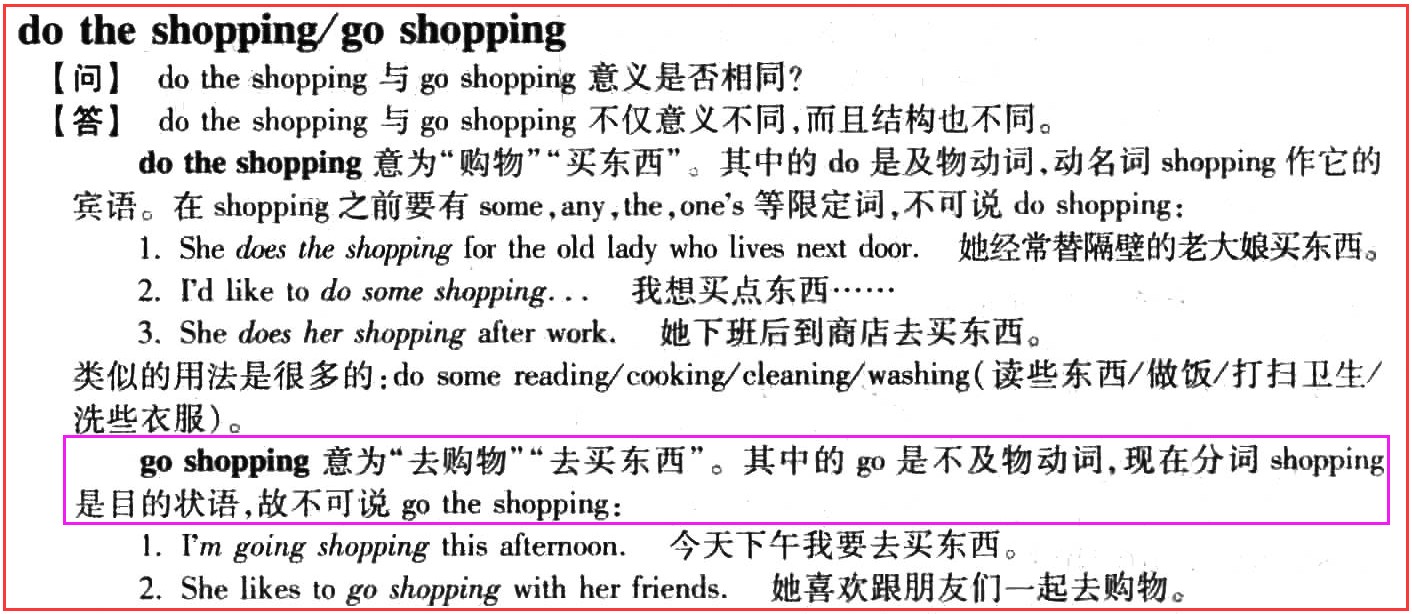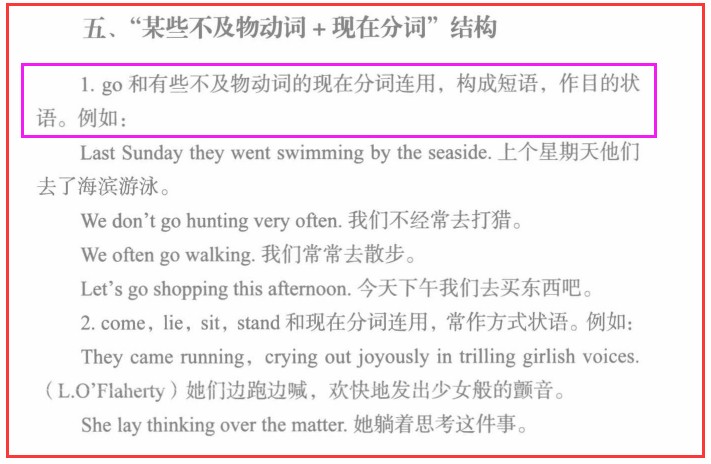2 现在分词(短语)可不可以作目的状语
最佳答案 2024-05-10 07:55
1. 谢谢网友邀答。通常我比较关注的是英语的习惯用法。对于句子成分的分析和术语的使用,尤其是一些细节末枝问题一般不太较真。像go swimming这样的go -ing结构,我一般将其视为习惯用法,也就是Betty Schrampfer Azar所称的idiomatic expresseions,通常不再做细分。它们在句法结构和语义上都是固化的。这样看问题比较简单省事,也是学习英语比较有效的态度。
2. 如果一定要将go后的-ing进行句子成分定位,我对不同意见持开放态度。因为实际上没有一致认可的标准答案。当然,各人都可能会有自己比较满意的解读。
章振邦把go –ing和come, sit, stand后加-ing分词分句视为“同类结构”,这一点我觉得不很合适。试比较:
(1)John has gone fishing.
(2)She came running to meet me.
(3)We sat telling stories to the children.
(4)He stood watching the soccer match.
句(1)的go fishing没有后续结构。此结构的-ing均为不及物动词用法,没有宾语。但句(2)、(3)和(4)的-ing分词都有后续结构。尤其后两句的-ing分词都有自己的宾语,它们的最合理成分是状语,表示方式或伴随状况。 所以我认为不宜把句(1)的go –ing与其它几句中的-ing分句用法混为一谈。
3. go –ing结构中的-ing分词,有人将其分析成目的状语我觉得也有一定道理。例如go fishintg,毕竟(正如牛津高阶说解释的)从语义上讲,fishing就是go的目的。
4. 但我个人的看法是,从句法功能上讲,这个-ing分词更像是个动名词,作go的补语(completion)。因为在这个-ing分词前有可能用名词作为修饰语。例如go window shopping, go water skiing, go ice akating, go mountain climbing等等。假如这些-ing形式不是动名词或不具名词特性,这种修饰方式是不可能成立的。
5. 把go –ing结构中的-ing视为动名词(实际上就是名词)也是有所依据的。朗文版Fundaments of English Grammar(2003)在介绍这一结构时指出:Go is followed by a gerund in certain idiomatic expresseions about activities. Notice: There is no to between go and the gerund.
英文词典也普遍把这一结构中的-ing视为名词(也就是动名词)。例如
Our neighbors like to go hiking in the mountains. (韦氏高阶)
We're going to go skiing in Colorado this winter. (朗文高阶)
They often go fishing. (牛津高阶)
There was no time to go sightseeing in Rome.(剑桥高阶)
I go jogging every morning. (麦克米兰)
You can go boating or play tennis. (柯林斯)
She likes to go shopping with her friends. (钱伯斯)
He went swimming in the river. (朗文分类)
各大词典都把上述各句的 (go) –ing明确列在noun这一词性之下。
最后,用Betty Schrampfer Azar给英语教师的下面这句话作为可作参考的小结:
Some grammarians disagree about the nature of these -ing words; are they gerunds or participles? For your students, terminology is much less important than idiomatic use. We will call these structures “gerunds.”
如果觉得我的回答对您有用,请随意打赏。你的支持将鼓励我继续创作!

- 2 关注
- 0 收藏,1498 浏览
- 静心 提出于 2024-05-08 08:33
相似问题
- -ing分词的成分判断(是作目的状语吗) 3 回答
- 区分不定式作宾补和目的状语,原因状语的疑惑 2 回答
- She has gone to buy some books.这句话里的不定式是目的状语 1 回答
- 目的状语修饰问题 1 回答
- 这里的to set off是目的状语吗 1 回答
-
 《高考英语备考1号·速效编》
《高考英语备考1号·速效编》
-
 《高考英语备考1号·写作编》
《高考英语备考1号·写作编》
-
 《高中英语晨读晚记》
《高中英语晨读晚记》
-
 《高中英语错题笔记》
《高中英语错题笔记》
-
 《零起点考大学英语》
《零起点考大学英语》
-


